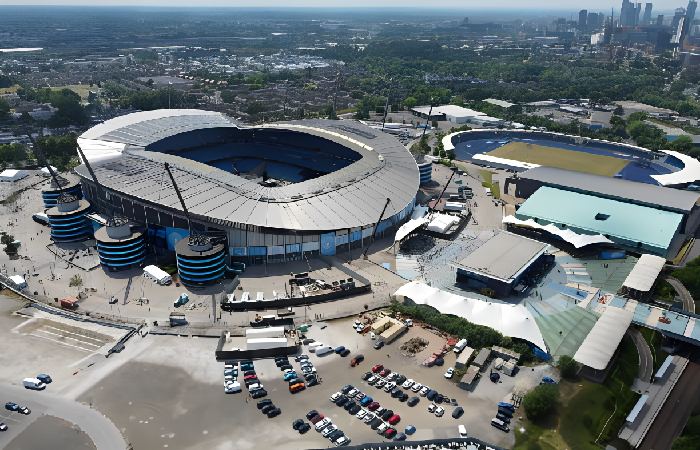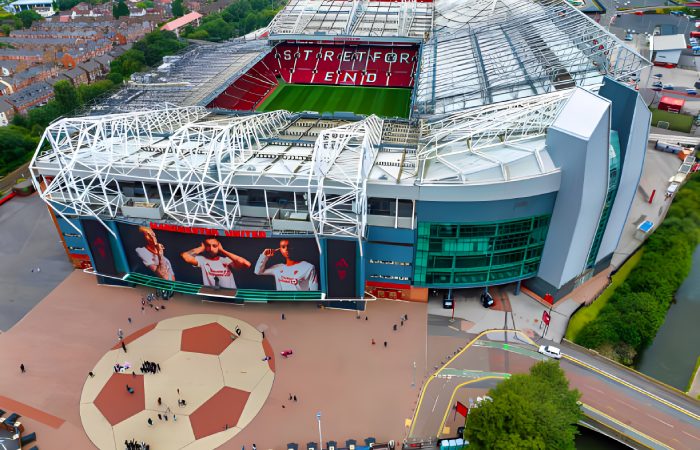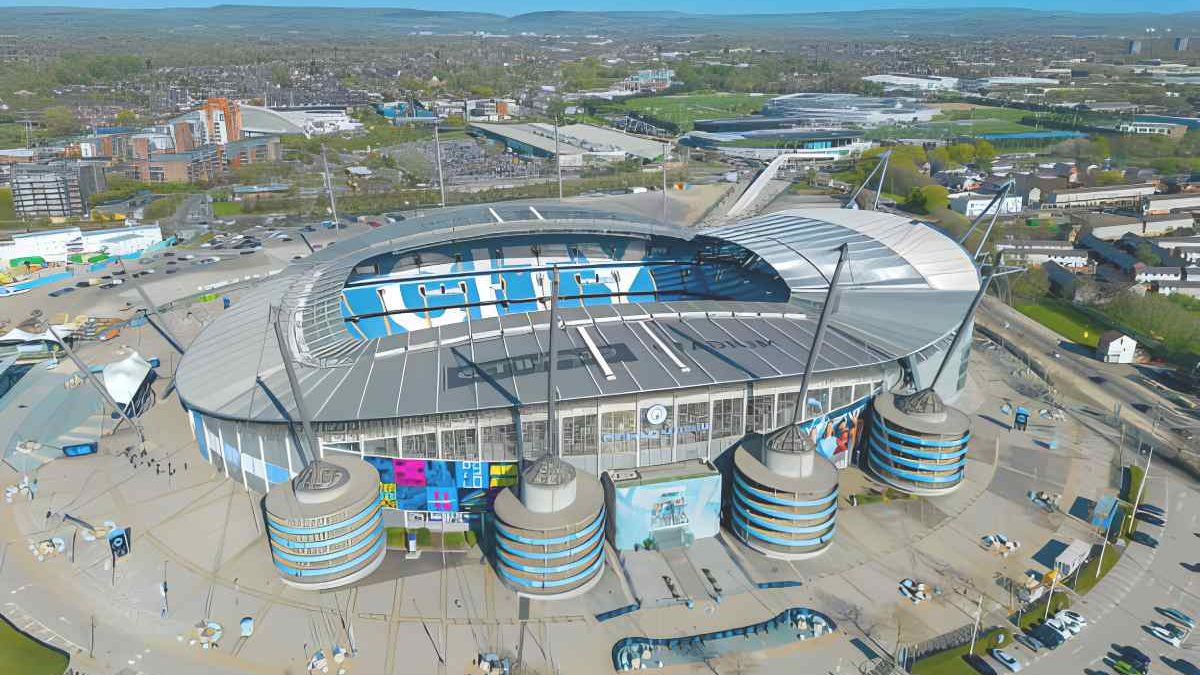Manchester City Stadion – The City of Manchester Stadium, generally called Etihad Stadium, is home to the international club Manchester City since 2003. Also, it is the eighth-largest stadium in the United Kingdom by capacity (55,097 spectators). The stadium hosts international football matches, music concerts and many other events. Arup Associates invested an estimated €112 million in its construction as a sports stadium.
The Etihad Stadium is known for its structure and design and won the Royal Institute of British Architects Award in 2004. In 2003 it won the Institute of Structural Engineers Special Award. The pitch surface is equipped with Desso Grass Master, making it one of the best pitches for association football matches.
Table of Contents
Significance
- The first concert at the Etihad Stadium was given by the Red Hot Chili Peppers and James Brown in 2004.
- The English rock band “Oasis” performed here at the concert held in 2005, which was attended by a record attendance of 60,000 people.
- The Stone Roses, Gorge Michael, One Direction, Bastille, Muse, Sugababes, Foo Fighters, Coldplay, Robbie Williams and Bruce Springsteen have performed at the stadium.
- “Hatton’s Homecoming”, the boxing fight between IBO light welterweight champion Ricky Hatton and Juan Lazcano also took place at this stadium in 2008.
- It hosted the final UEFA Cup match in 2008, played between Zenit Saint Petersburg of Russia and Rangers F.C. of Scotland.
- Apart from many well-known championships, this stadium has also hosted England international football matches, boxing events and Rugby League matches, the last of which was the 2015 Rugby World Cup.
- The Etihad Stadium hosted the UEFA Women’s Championship in 2005, as well as the 2011 UEFA Championship League final.
History
The stadium in east Manchester was drawn up around 1990 as part of the city’s bid to host the 2000 Summer Olympics. Manchester City Council funded the design of an 80,000-seat stadium on an abandoned piece of land known as Eastlands. In October 1993, the sports were awarded to Sydney, Australia. Manchester has successfully attempted to host the 2002 Commonwealth Games. It is used for the stadium plans from the Olympic bid. In 1996, the planned stadium strived with Wembley Stadium for the funding to become the national stadium. Instead, the money was used to rebuild Wembley.
The foundation stone for Manchester City’s stadium. It was laid by Prime Minister Tony Blair in December 1999. Construction began in January 2000. The stadium was planned by Arup and built by John Laing. The stadium cost around £110 million. Of this, £77 million was paid by Sport England and the rest by Manchester City Council. For the Commonwealth Games, the stadium had a lower level along 3 sides of the athletics track. There was a second level on both sides. There was a temporary outdoor stand at one end. Although, the first public event at the stadium was the inaugural ceremony of the Commonwealth Games 2002 on July 25, 2002. Among the celebrities attending the ceremony was Queen Elizabeth II. During the ten days of rivalry, the stadium hosted all athletics and rugby sevens events.
Parts of the Stadium

The exterior of the stadium. Steel cables hold the roof in place.
The interior of Manchester City’s stadium is an oval bowl. It has three levels of seating on the sides and two levels at each end. Even though the seats form a solid bowl, each side of the stadium has its name. It’s like any other football field. At first, all sides of the stadium were named according to the direction indicated by the compass.
The roof of the stadium has a toroidal shape (like a doughnut). It is postponed from steel cables attached to eight towers. These provide access to the upper seating level via spiral ramps. Non-seating areas in each corner feature movable slats. This allows air to circulate across the field. Entry is via a contactless smart card instead of the usual turnstile. This system can accommodate up to 1,200 people per minute at all entrances. A service tunnel running under the stadium allows access for emergency vehicles. Allows the visiting team bus to enter the stadium directly. Inside the stadium, there are six themed restaurants. Two of the restaurants offer views of the countryside. There are several conference facilities. The stadium is also licensed for wedding ceremonies.
Manchester City’s stadium has a pitch of standard UEFA dimensions, 105 by 68 meters (344 feet × 223 feet). It is a natural grass pitch reinforced with artificial grass fibres manufactured by Desso. There are 218 floodlights in the stadium. Each uses 2000 watts. In total, they consume 436,000 watts when all turned on.
Manchester City Stadium or Club Tour

The Stadium Tour is the most amazing tourism experience in Premier League football. Thanks to the latest technology, dreams come true when you and your loved ones sit and interrelate with Pep Guardiola in the press room.
Feel fully immersed in the city’s history with our new 360-degree cinema experience and be amazed by the impressive audio-visual experience in the first team dressing room. There is a surprise at every step! Led by expert tour guides behind the scenes of the stadium, each area will come to life with interesting stories, facts and anecdotes. It’s more than a stadium tour: this unique experience brings the magic of the city to life!
What’s included
- Questions on the ground with a virtual Pep Guardiola at a press conference
- Explore the exciting new exhibition space with holographic content
- See the city’s history come to life in the new immersive 360-degree cinema
- Find out what happens during the day in the home team’s locker room, with a new immersive audiovisual show
- Feel what it’s like to pass through the famous glass tunnel of the players and enter the field.
- Take to the field and view the stadium from the dugouts through Pep’s eyes.
- Walk through the multi-award-winning hospitality suite, The Tunnel Club
- Visit the visiting team’s locker room
- Understand how players prepare for the big game in the first-team warm-up area
- Take home the perfect souvenir from your visit to the City Store
- All tours are explained in different languages using the latest cutting-edge multimedia guides.
- Languages include French, German, Italian, Mandarin, Spanish, Korean, Arabic and Portuguese.
Timings and Prices
Tours run daily from 10 am to 4 pm* (Tour times may vary depending on the time of year)
*Except for match days. The tour is subject to change at short notice depending on operational requirements.
Transport
Manchester City’s stadium is located to the east of Manchester city centre. The stadium site has 2,000 parking spaces. A further 8,000 seats around the stadium. They are provided by local businesses and schools working with the football club. The nearest train station is Ashbury. It’s a 20-minute walk south of the stadium. Services are partial due to the small size of the station. The Manchester Piccadilly, where mainline trains depart from London, Birmingham and Edinburgh. It is a 30-minute walk away. Several special bus services arrive at the stadium when events are taking place.
An expansion of the Metrolink light rail system stopping at the stadium was announced in 2000. However, after a review of public spending, the plan was suspended in July 2004. In July 2006, funding for the expansion was restored, but for a shorter duration. A Sportcity Metrolink station opened on February 11, 2013.
How to Get There
The Etihad Stadium is in east Manchester. Take the Metrolink tram blue line or orange line (Ashton-under-Lyne) to ‘Etihad Campus station or a taxi is 10 minutes from Piccadilly.
Please try to avoid bringing any baggage to the Etihad Stadium. All baggage will be searched before gaining entry to the Stadium. Suitcases and cabin bags will be searched and stored in a secure location.
Concerts
The stadium hosts concerts. It is one of the largest concert halls in the United Kingdom. Its maximum capacity is 60,000 people for performances. The first concert at the stadium was a presentation by the Red Hot Chili Peppers in 2004. The support by James Brown. Manchester City supporters Oasis have performed concerts at the stadium`. One of his shows appeared on his Lord Don’t Slow Me Down DVD. Another Manchester band, Take That, also released a DVD of their performance at the stadium. The Ultimate Tour.
Other artists who have had fun at the stadium include U2 and Rod Stewart. The Fighters were supported by Manic Street Preachers and The Futureheads, Bon Jovi and George Michael.
In June 2018, Taylor Swift premiered her “Reputation Stadium Tour” in the United Kingdom over two nights.
Summer activities, like concerts and boxing matches, often destroy the playing field. In 2008, end-of-season fixes, coupled with the early start of the football season, meant the field was not ready in time for the first scheduled home game. For this reason, Manchester City played their UEFA Cup first-round qualifying match at the Oakwell Stadium in Barnsley.
Conversion of Manchester City Stadium from an Athletics venue to a leading Football Club
The gun trigger for the conception of the City of Manchester Stadium was a single event, the 17th Commonwealth Games in 2002. However, the conditions for its creation required it to become a viable legacy for the iconic and catalytic city of Manchester. . for regeneration. The Games themselves only lasted 10 days, but the stadium would be used by Manchester City Football Club for many years, as well as serving as a “neutral” venue for major cup competitions and concerts occasionally.
The economy of the Commonwealth Games was largely dependent on television viewing figures. The temporary grandstands and facilities needed to run the event were designed to be largely off-camera during the spectacular opening or closing ceremonies and track finals. British Premier League football clubs, in contrast, rely much more on ticket sales for their revenue, meaning that some temporary facilities acceptable for the Games would not meet the club’s needs.
The project demonstrates the potential for flexible design through a staged construction process, enabling use for different sequential events, each requiring significantly different capacity and configuration.
Undercover from a Commonwealth Stadium to a Football Stadium
The successful two-stage design of the stadium to meet its initial necessities as an athletics venue, before adapting it for permanent football use.
To provide the athletics track for the Commonwealth Games, and the stadium had to be extended.
The first stage of construction involved the completion of three sides of the Everlasting Stadium, with a temporary grandstand to supplement the remainder of the seats for the duration of the Games.
In the second phase, the track was dismantled, the floor was lowered by 6m, 90,000m3 of the earth was removed, a lower section was installed to provide 24 additional rows of seats and the temporary grandstand was replaced. The bowl, which initially covered three-quarters of the horseshoe-shaped stadium, was made for the football stadium.
The main structural system consisting of masts and cables, completely independent of the roof plate structure, was completely constructed in the initial phase.
The secondary structure was completed by the construction of the north stand in the second phase. , The project shows the value that can be achieved through strategic design, avoiding the redundancy associated with large one-off events.
Comfort, Convenience and Security
When designing for effective crowd management, the design of stadium circulation systems is essential. The entrance ramps allow the public to enter and exit the stadium quickly and safely, and their gentle slope facilitates access for people in wheelchairs. The innovation in the turnstile design, configured with a 120° rotating arm, provides users with greater space when entering the stadium. However, the factors combine to provide a reassuring arrival experience. They also reduce waiting times and pre-match hustle and bustle, which reduces operating costs as ticket inspectors are not required.
An innovative fire strategy, using double roller boards without a sprinkler system and containing numerous services in the towers, allowed the creation of continuous entrance halls. These allow for mass removal and provide large, clean, clear spaces so users can easily move to concessions and bathrooms located throughout the building, avoiding the typical halftime rush to freshen up and relieve yourself. These spacious entrance halls, designed like “streets”, meet the objectives of coherence, clarity and comfort for the project’s users.
Conclusion
Manchester City signed an agreement with Council in March 2010 to allow the land around the stadium to be redeveloped. This could include adding additional seats to reach 60,000 seats in the stadium. Work on the pitch around the stadium began in September 2010. The club is also in talks with Manchester City Council to sign a new lease for the future stadium.
Immerse yourself in the city’s history and gain unprecedented access to the home of the treble winners with this exclusive Manchester City Stadium and the Football Academy tour for one adult and one kid.
Fans will benefit from everything included in the Manchester City stadium tour, as well as a 360-degree insight into the life of a City footballer, visiting the training facilities and understanding how footballers prepare for the big match, ending with a trip. around the Etihad Stadium. Thanks to the latest technology, dreams come true when you and your loved ones sit and interact with Pep Guardiola in the press room.
Exit the glass players’ tunnel, sit in the dugouts and enjoy the view of the stadium from the field. Expertly guided by city tour guides, expect a surprise at every turn during this truly magical look into the world of Manchester City.

